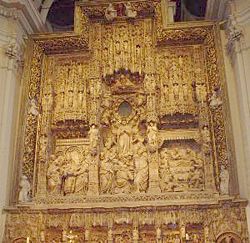Damià Forment
The sculptor Juan de Salas was one of his apprentices, and later was employed carving images for his master in wood and alabaster, being paid based on the area of the work.
He is also known for the altarpieces of the churches of San Miguel de los Navarros and San Pablo, both in Zaragoza, of the cathedral of Huesca (1520–24), done in the Mannerist style; the altar of the Poblet Monastery (1527), his first work entirely in the Renaissance style;[7] and for his last work, the Renaissance altar of the Cathedral of Santo Domingo de la Calzada (1537–40).
His most important and controversial is the altarpiece for the monastery of Poblet (Tarragona), who commissioned the abbot Caixal, white alabaster.
Forment left numerous disciples and followers as Juan de Salas and son Felipe Gregorio Pardo Vigarny.
Some of these memorials are considered proper altarpieces with their definition: work-tabula-back-back-the altar, which tells stories of character religioso.

